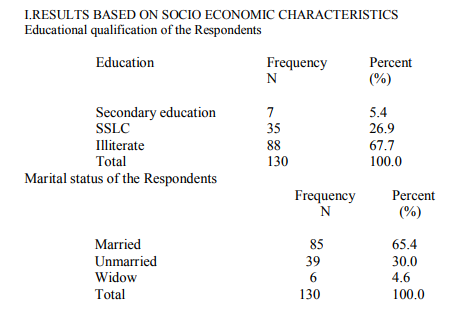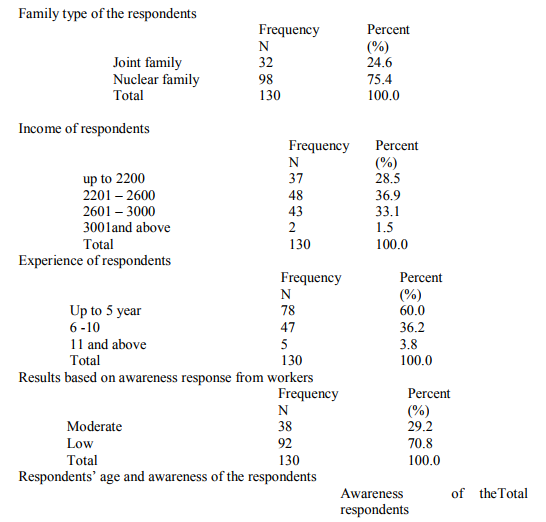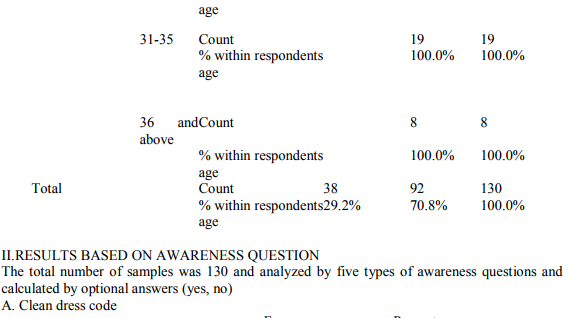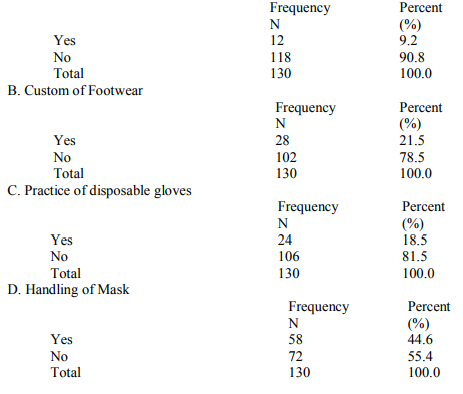IJCRR - 4(17), September, 2012
Pages: 133-140
Date of Publication: 14-Sep-2012
Print Article
Download XML Download PDF
OCCUPATIONAL AWARENESS OF RURAL WOMEN WORKERS IN HEN POULTRY FARM, COIMBATORE DISTRICT, SOUTH INDIA
Author: Sharmila Banu A, Gunasekaran C, SelvaKumar V, Mohana P, Kandappan , K, Elanchezhian M
Category: General Sciences
Abstract:Frequently the rural area women?s are first-rate the preference to poultry works. Especially women?s are the
majority to work on this field. Rural areas are mainly depends on the women incomes. The present research focus to
scrutiny the occupational awareness in hen poultry farm, in specific reference to faecal cleaners of women workers.
The foremost objective of the research is to bestow the awareness about work place and mould with them health and
safety decisive factor. The calculation is done by percentage (%) intensity and chi-square test. The recommendations
in addition discuss among women workers.
Keywords: occupational awareness, rural, hen faecal cleaning women, livelihood, percentage and chi-square test.
Full Text:
INTRODUCTION
Even though they are home makers, but they are forced to work for their family. This is help to their children future and they have a thought about empowerment development. The women are the backbone of agricultural workforce but worldwide her hard work has mostly been un paid. She does the most tedious and back-breaking tasks in agriculture, animal husbandry and homes (DARE/ICAR ANNUAL REPORT 2003–2004). The choice of occupation is traditionally (Penny Kane) or time being taken to commencing of rural women?s and they have the poor dexterity of occupation effects. Thus, the rural women?s are randomly selects the hen poultry farm. In particularly, we have one question: Why, the research is to selects the poultry farm and especially in women workers. Because, POULTRY is by far the largest livestock group and is estimated to be about 14 000 million, consisting mainly of chickens, ducks and turkeys (FAO 1999).One third of the world is moving only the food of chicken. Women are the back fillet of the whole lot in family. She have to work for all the relationships like Mother, Daughter, Sister, Grand mother, worker in occupation etc. She didn?t feel difficulty with anything which comes from family or occupation. The bacterial count in poultry housing systems is high in comparison to those of pig and cattle. Little is known about the bacteria present in the poultry environment such as in poultry litter and air of poultry house (Saleh et al., 2003, Nasrin etal). Micro organisms like Bacteria, (USA Wrestling 2007-08) fungi-Small organisms that are found everywhere in the environment and on skin. Whereas their population is more high in pollutants and excrete area like animal faeces. These organisms move under the skin and start the problem to the humans. In poultry farm may cause the problems of infection disease respiratory problems and so on, these overwhelming effects to the worker when they have not any idea about basic occupational skill (safety manners). The possible negative effect of noise on reproduction is biologically plausible, as well as amenable to prevention (Irene Figà-Talamanca). So the research have in mind of these points of basic health problems and its root will be spread when the daily habits are not in following the proper comportment such as clean dress, wear the gloves and mask, and footwear. Since, these are the fundamental to hygienic working people. The present research asked the question about clean dress, wearing the gloves, mask, footwear?s and hand washing habits. These all done by direct interview method. This analysis is calculated by percentage (%) variation. Based on the results they urge.
METHODOLOGY
The research work was conducted on the rural women worker in hen poultry farm in Coimbatore District. After approval from Institutional Ethics Committee,(Kartik et al 2005) the research was on track with conquering an informed permission from the partaker of poultry farm. Totally 130 samples were selected for this research which included age group of Up to 25 with 29 samples (group I), 26-30 with 74 samples (group II), 31- 35with 19 sample (group III), 36 an above with 8 sample (group IV) and the study was conducted during the epoch 3rd -24th May 2012.The study was vigilance by direct interview method, we calculated the percentage of women?s worker awareness through the questionnaire include the 5 basic question, this also designed by the points of daily activity such as clean dress code, wearing gloves and mask , footwear then washing habit of hands, and the answers were corrected with options of 1.Yes, 2.No then this research was successfully completed by the percentage and chisquare test calculations. The Direct interview Questions are following A. Are they workers maintaining the dress code (a clean pair of working dress) to work place? B. Are they having the habit to wear footwear in work place? C. Are they wearing the disposable gloves? D. Are they use the mask at work place? E. Are they washing hands before drinking water? The standard optionally answers were assessed directly by the research team. Based on the options the findings were examined.






DISCUSSION
The present research was focused to identified the occupational awareness in rural area especially women workers in hen poultry farm. In the attendance the research encounter only the fecal cleaners. Why? The study concentrated to faecal cleaners because they were more infected through the excrete materials in poultry farm ,According to Mojtaba Yegani (2010)Zoonotic diseases are transmitted from animals to humans and include bacterial, viral, fungal, and parasitic diseases. Salmonellosis, campylobacteriosis, chlamydiosis, tuberculosis, Newcastle Disease, and avian influenza are amongst the most common zoonotic diseases transmitted from poultry to humans. Poultry workers are at a greater risk of being affected by these diseases. This review also support to our research. Based on the results the age group of up to 25 was more aware worker than the rest of the age group. Why? The research team asked the question about clean dress means some worker have the habit to wear pair of dress for work time, some of the worker have the habit to wear clean dress in daily basis, but few of the workers used the dress for two day or three days. The table A. question only 12 samples answered and the percentage was 9.2%, High percentage was 90.8% found from 118 samples. Similar to the second question about the habit of foot wear, why? We had chosen this, because any time every minute whenever we want anything we used only our travel pack of legs, sometime we may go hospital for children or elders and reach our home without footwear means it can spread the growth of microbial diversity through work place. The table B shows in the percentage of 21.5 from 28 samples and high percentage from 102 samples. The third question asked about gloves, why? The research team set this kind because hands are the direct conduct to get the infection; through the use of hand they cleaned the fecal ooze material. This material has the quality to induce in the skin and cause diseases and hands are the machine for everything like eating, cooking, washing etc. without proper practice in the work place we may get the foundation of ill. So cleaning is the main factor of the above. The table C shows the percentage variation like start from 24 samples of 18.5 and the 81.5 percentage from 106 samples. It.s basic. It.s simple. The number one way to improve health in rural areas is not to provide clean water; that comes in third. It is much easier than that: teach people how to wash their hands (Mihelcic, 2003). Third world communities suffer greatly from preventable water borne diseases and from diseases spread through poor hygiene practices. By improving sanitation and environmental conditions in the communities and implementing an educational program of health and hygiene education appropriate for the community, the numbers of preventable deaths and illnesses have been shown to decrease (Panchita Paulete,2003). According to WHO guidelines for indoor air quality: dampness and mould, Exposure to microbial contaminants is clinically associated with respiratory symptoms, allergies, asthma and immunological reactions. The microbial indoor air pollutants of relevance to health are widely heterogeneous, ranging from pollen and spores of plants coming mainly from outdoors, to bacteria, fungi, algae and some protozoa emitted outdoors or indoors. They also include a wide variety of microbes and allergens that spread from person to person. There is strong evidence regarding the hazards posed by several biological agents that pollute indoor air; however, the WHO working group convened in October 2006 concluded that the individual species of microbes and other biological agents that are responsible for health effects cannot be identified. This is due to the fact that people are often exposed to multiple agents simultaneously, to complexities in accurately estimating exposure and to the large numbers of symptoms and health outcomes due to exposure. The exceptions include some common allergies, which can be attributed to specific agents, such as house-dust mites and pets. So, it?s our duty to be safe in work place and in environment, based on this statement the research team frames the question about wearing of mask at work place, this will help to control the respiratory problems. The table D showed the percentage of 58 samples 44.6 and 72 samples 55.4.Improved hygiene (hand washing) and sanitation (latrines) have more impact than drinking water quality on health outcomes, specifically reductions in diarrhea, parasitic infections, morbidity and mortality, and increases in child growth,.(Water, sanitation and hygiene, 2002).the research team included the question about washing hands before drinking water or any intervals based on the answered from the samples the finding were done. The table E shows the 35.4 percentage from 46 samples and 64.6 from 84 samples respectively. The chi-square test valuable were calculated by the factors of age and awareness, income and awareness, experience and awareness. The Pearson chisquare value was 14.75, Degrees of freedom was 3 and p value was .002(less than .05) these were the values of age and awareness. The income and awareness was Pearson chisquare value 20.155, degrees of freedom 3 and p value was .000(less than 0.05).The experience and awareness were Pearson value 0.817, the degrees of freedom was 2 and p value was 0.665.From the chi-square results the research find out that experience is not mould the person directly but some cases it can. Age is the factor this is have the ability to know that what we will do or what we didn?t. Because the research were not get the significance in experience where as the significance appear in age and income compared with awareness. Hygienic and health conscious to support our immune actions. The research questions such as wearing footwear, to avoid the microbial infection in legs and foot and the questions of gloves and mask were support to the workers from respiratory problems like sneezing, cough and cold. Washing hands and wearing clean dress are important to live good life. These are the basic questions arise from the research team and observed by direct interview method. This is the first stage in a process that helps empower members of a community. To assess their knowledge base, investigate the local environment, visualize a future scenario, analyze constraints on change, plan for change, and implement it,. (PHAST, 1998).Based on this review support, our research was analyzing the occupational environment on rural women workers in first stratum.
CONCLUSION
During the month of period the research was conducted on hen poultry with randomly selected 130 samples in various poultry farm. Whenever, we interview the women workers by directly that time on spot awareness created to them its shows visibly. After two or four hours the awareness was disappear. This is because of the care less and not giving the preference to health and long life. But awareness not only the source to protect them, apart from this self appraisal with awareness of each individual concentration is more important than the voice arise from the researcher. As a result we entitled the aphorism to their hearts that is REALIZE your work and know the REALITY of your occupation, THIS WILL REDUCE THE OCCUPATIONAL PROBLEMS of health.
ACKNOWLEDGEMENT
I thank to God to have this opportunity to do something good to society especially women workers, Our sincere thanks to Dr.Sasikala, head and professor, Department of Zoology, Bharathiar University, with her support and encourage completing this work in smooth way. Gratitude to Institutional Human Ethical Committee of Bharathiar University for permit the research work. Our heart full thanks to poultry farm women workers for their patience and managing director, supervisor and last but not least Self Help Group members for their support in this field. Authors acknowledge the immense help received from the scholars whose articles are cited and included in references of this manuscript. The authors are also grateful to authors / editors / publishers of all those articles, journals and books from where the literature for this article has been reviewed and discussed.
References:
1.FAO 1999. Statistical database, www.fao.org. Food and Agriculture Organisation of the United Nations. Rome,Italy.Houghton, MI.
2.Irene Figà-Talamanca Occupational risk factors and reproductive health of women Department of Hygiene and Industrial Health, University of Rome „La Sapienza?, Piazzale Aldo Moro 5, 00185 Roma, Italy. e-mail: irene.figatalamanca@uniroma1.it
3.Jim Porter, USA Wrestling MRSA and other Infection Facts Making Wrestling Safer Guide to Recognition of Skin Infections james.porter@selectmedicalcorp.com
4.Kartik R Shah and Rajnarayan R Tiwari 2005, OCCUPATIONAL SKIN PROBLEMS IN CONSTRUCTION WORKERS Indian J Dermatol. 2010 Oct-Dec; 55(4): 348– 351.doi: 10.4103/0019-5154.74537
5.M.S. Nasrin, M.J. Islam, K.H.M.N.H. Nazir, K.A. Choudhury and M.T. Rahman1 Identification of bacteria and determination of their load in adult layer and its environment Dept. of Microbiology and Hygiene, Bangladesh Agricultural University, Mymensingh-2202, Bangladesh J. Bangladesh Soc. Agric. Sci. Technol., 4(1 and 2): 69-72, 2007 ISSN 1811-6221
6.Mihelcic, Jim, Ph.D. Lecture. (13 March 2003).Michigan Technological University. Houghton, MI
7.Mojtaba Yegani, 08 Jul 2010 Prevention / Control Health hazards: Safety always comes first, University of Alberta, Canada
8.Panchita Paulete (May 2003), Practice and importance of combining health/hygiene and environmental education with water sanitation for sustainable health benefits in rural areas School of Forest Resources and Environmental Science Michigan Technological University, Houghton, MI
9.Penny Kane, Senior Associate, Editor WOMEN and OCCUPATIONAL HEALTH, Issues and policy paper prepared for the GLOBAL COMMISSION ON WOMEN'S HEALTH The Office for Gender and Health, The University of Melbourne, Australia
10.PHAST Initiatives in East Africa. (1998). The World Bank. Presented at the Community Water Supply and Sanitation Conference,Washington, DC.http://www.wsp.org/english/focus/conference/ hyg_phast.pdf SOPAC WRU Strategies
11.Saleh, M., Seedorf, J. and Hartung, J. 2003. Total count of bacteria in the air of three different laying hen housing systems. Dtsch. Tierarztl. Wochenschr., 110(9): 94-97.
12.Water, sanitation and hygiene: at a glance..(March 2002). World Bank Group. http://wbln0018.worldbank.org/HDNet/hdd 60/9d1422d8016e85d885256b90005e1f76/$FILE /5WatSan%20AAG.pdf
13.WHO guidelines for indoor air quality :dampness and mould This document presents World Health Organization (WHO) guidelines for the protection of public health from health risks due to dampness, associated microbial growth and contamination of indoor spaces oct 2006
14.WOMEN IN AGRICULTURE, (DARE/ICAR ANNUAL REPORT 2003–2004)
|






 This work is licensed under a Creative Commons Attribution-NonCommercial 4.0 International License
This work is licensed under a Creative Commons Attribution-NonCommercial 4.0 International License